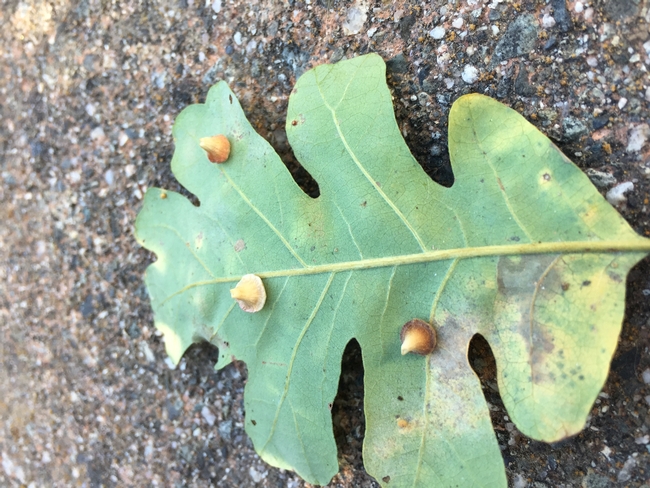Advice for the Home Gardener from the Help Desk of the
UC Master Gardener Program of Contra Costa County
Client's Request: Below is a picture of a leaf from my oak tree in my yard. I believe I noticed these weird trumpet shaped “housings” on the fallen leaves last year, but this year it's very prolific. We have 3 large trees. I'm hoping they are not infested with something bad? Any advice would be very appreciated.

What you are seeing on the leaves are galls. Galls are abnormal growths that can occur on leaves, twigs, acorns, catkins, and petioles in response to irritation and/or stimulation of plant cells. In your situation, the galls are formed on leaves due to egg-laying by the gall wasps. Virtually all native California oak species are hosts to one or more gall wasp species. After female wasps lay eggs, the developing larvae produce substances that induce the plant to form a gall. The larvae remain small while they induce the gall to grow rapidly. As the gall nears its mature size, larvae feed on nutritive tissue produced in the center of the gall and begin to grow rapidly. Larvae pupate within the gall and adult wasps emerge from the galls to initiate the next generation.
The good news is that most wasp galls, especially galls on leaves, cause little or no lasting damage to oaks. A few galls may cause limited leaf or twig die back by blocking the vascular tissue. If the oaks are provided with proper environmental conditions and good cultural care, no other management is recommended because gall wasps can be very difficult to control and usually they do not seriously harm oaks.
If you are interested in reading about gall wasps, here are a few references:
http://ipm.ucanr.edu/PMG/GARDEN/PLANTS/INVERT/oakgallwps.html
http://cesanluisobispo.ucanr.edu/news_873/Livestock-_Range-_Watershed-_Oaks/Oak_Galls_/
USDA: A Field Guide to Insects and Pathogens of California Oaks – Pg 28 (https://www.fs.usda.gov/treesearch/pubs/25928)
I hope I have identified your problem to your satisfaction. Please do not hesitate to contact us if you have further questions. Happy Gardening!
| Editor's Notes: Versions of these oak galls were apparently quite common this summer in Contra Costa County, at least based upon interest from questions to Master Gardeners. As noted above, there are many manifestations of this “pest”, the most interesting is probably the pink galls. MGCC has provided some information on them in a previous blog at http://ccmg.ucanr.edu/HortCoCo/?blogpost=18522&blogasset=12496 |
Help Desk of the UC Master Gardener Program of Contra Costa County (BY)
Note: UC Master Gardeners Program of Contra Costa's Help Desk is available almost year-round to answer your gardening questions. Except for a few holidays (e.g., last 2 weeks December), we're open every week, Monday through Thursday for walk-ins from 9:00 am to Noon at 2380 Bisso Lane, Concord, CA 94520. We can also be reached via telephone: (925) 608-6683, email: ccmg@ucanr.edu, or on the web at http://ccmg.ucanr.edu/Ask_Us/.
MGCC Blogs can be found at http://ccmg.ucanr.edu/HortCoCo/ You can also subscribe to the Blog (//ucanr.edu/blogs/CCMGBlog/)